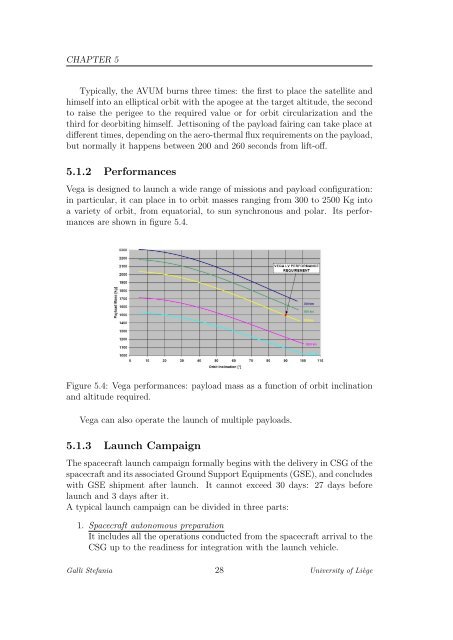Mission Design for the CubeSat OUFTI-1
Mission Design for the CubeSat OUFTI-1 Mission Design for the CubeSat OUFTI-1
CHAPTER 5Typically, the AVUM burns three times: the first to place the satellite andhimself into an elliptical orbit with the apogee at the target altitude, the secondto raise the perigee to the required value or for orbit circularization and thethird for deorbiting himself. Jettisoning of the payload fairing can take place atdifferent times, depending on the aero-thermal flux requirements on the payload,but normally it happens between 200 and 260 seconds from lift-off.5.1.2 PerformancesVega is designed to launch a wide range of missions and payload configuration:in particular, it can place in to orbit masses ranging from 300 to 2500 Kg intoa variety of orbit, from equatorial, to sun synchronous and polar. Its performancesare shown in figure 5.4.Figure 5.4: Vega performances: payload mass as a function of orbit inclinationand altitude required.Vega can also operate the launch of multiple payloads.5.1.3 Launch CampaignThe spacecraft launch campaign formally begins with the delivery in CSG of thespacecraft and its associated Ground Support Equipments (GSE), and concludeswith GSE shipment after launch. It cannot exceed 30 days: 27 days beforelaunch and 3 days after it.A typical launch campaign can be divided in three parts:1. Spacecraft autonomous preparationIt includes all the operations conducted from the spacecraft arrival to theCSG up to the readiness for integration with the launch vehicle.Galli Stefania 28 University of Liège
CHAPTER 5.MISSION ANALYSISIt can be divided in two parts: the spacecraft preparation and checkout includingthe assembly and functional test, the verification of the interfacewith the launch vehicle and the battery charging (fig. 5.5) and the spacecrafthazardous operations including the filling of satellite’s tanks withfuels (fig. 5.6).Figure 5.5: Vega: spacecraft preparation and checkout phaseGalli Stefania 29 University of Liège
- Page 3: Space is probably the main symbol o
- Page 7 and 8: CONTENTS1 Introduction 132 The LEOD
- Page 9 and 10: LIST OF FIGURES4.1 A typical 1-unit
- Page 11: LIST OF TABLES5.1 Comparison betwee
- Page 15 and 16: CHAPTER2THE LEODIUM PROJECTThe LEOD
- Page 17: CHAPTER3THE FLIGHT OPPORTUNITYThe E
- Page 20 and 21: CHAPTER 44.1 The CubeSat conceptDur
- Page 22 and 23: CHAPTER 4have to be smooth and thei
- Page 25 and 26: CHAPTER5MISSION ANALYSISThe mission
- Page 27: CHAPTER 5.MISSION ANALYSIS5.1.1 Typ
- Page 31 and 32: CHAPTER 5.MISSION ANALYSISFigure 5.
- Page 33 and 34: CHAPTER 5.MISSION ANALYSIS5.2 The o
- Page 35 and 36: CHAPTER 5.MISSION ANALYSIS• the s
- Page 37 and 38: CHAPTER 5.MISSION ANALYSISt − t 0
- Page 39 and 40: CHAPTER 5.MISSION ANALYSISIn figure
- Page 41 and 42: CHAPTER 5.MISSION ANALYSIS• if m
- Page 43 and 44: CHAPTER 5.MISSION ANALYSIS5.3.3 The
- Page 45 and 46: CHAPTER 5.MISSION ANALYSISwhere ϑ
- Page 47 and 48: CHAPTER 5.MISSION ANALYSISFigure 5.
- Page 49 and 50: CHAPTER 5.MISSION ANALYSISA four ye
- Page 51 and 52: CHAPTER 5.MISSION ANALYSISFigure 5.
- Page 53 and 54: CHAPTER 5.MISSION ANALYSISFigure 5.
- Page 55: CHAPTER 5.MISSION ANALYSISFigure 5.
- Page 58 and 59: CHAPTER 66.1 Pumpkin structureThe s
- Page 60 and 61: CHAPTER 6Figure 6.2: ISIS structure
- Page 62 and 63: CHAPTER 6Figure 6.3: P-POD: deploym
- Page 64 and 65: CHAPTER 77.1 Inertia propertiesBefo
- Page 66 and 67: CHAPTER 7I x = I x,cube + I x,M + I
- Page 68 and 69: CHAPTER 7This rough estimation is e
- Page 70 and 71: CHAPTER 7Otherwise, an orbit simula
- Page 72 and 73: CHAPTER 7only slow down the rotatio
- Page 74 and 75: CHAPTER 8order to prevent any failu
- Page 76 and 77: CHAPTER 8We have now the vector ˆN
CHAPTER 5Typically, <strong>the</strong> AVUM burns three times: <strong>the</strong> first to place <strong>the</strong> satellite andhimself into an elliptical orbit with <strong>the</strong> apogee at <strong>the</strong> target altitude, <strong>the</strong> secondto raise <strong>the</strong> perigee to <strong>the</strong> required value or <strong>for</strong> orbit circularization and <strong>the</strong>third <strong>for</strong> deorbiting himself. Jettisoning of <strong>the</strong> payload fairing can take place atdifferent times, depending on <strong>the</strong> aero-<strong>the</strong>rmal flux requirements on <strong>the</strong> payload,but normally it happens between 200 and 260 seconds from lift-off.5.1.2 Per<strong>for</strong>mancesVega is designed to launch a wide range of missions and payload configuration:in particular, it can place in to orbit masses ranging from 300 to 2500 Kg intoa variety of orbit, from equatorial, to sun synchronous and polar. Its per<strong>for</strong>mancesare shown in figure 5.4.Figure 5.4: Vega per<strong>for</strong>mances: payload mass as a function of orbit inclinationand altitude required.Vega can also operate <strong>the</strong> launch of multiple payloads.5.1.3 Launch CampaignThe spacecraft launch campaign <strong>for</strong>mally begins with <strong>the</strong> delivery in CSG of <strong>the</strong>spacecraft and its associated Ground Support Equipments (GSE), and concludeswith GSE shipment after launch. It cannot exceed 30 days: 27 days be<strong>for</strong>elaunch and 3 days after it.A typical launch campaign can be divided in three parts:1. Spacecraft autonomous preparationIt includes all <strong>the</strong> operations conducted from <strong>the</strong> spacecraft arrival to <strong>the</strong>CSG up to <strong>the</strong> readiness <strong>for</strong> integration with <strong>the</strong> launch vehicle.Galli Stefania 28 University of Liège



